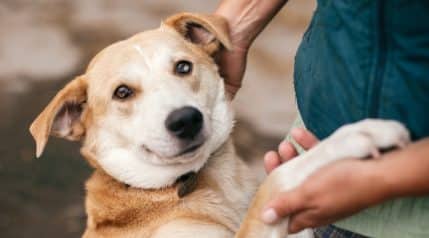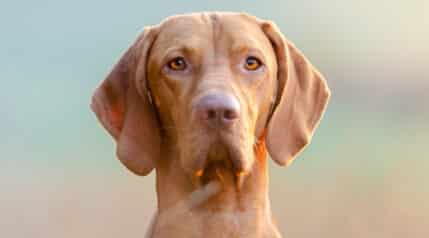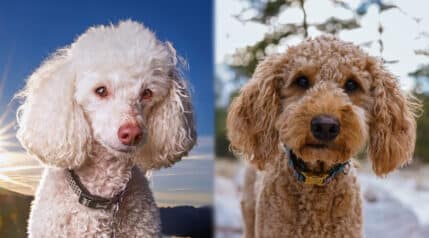Are you curious about whether the Giant Schnauzer is the next dog for you? This breed information guide runs you through all of the facts you need to know to answer this question. From their commanding and sometimes dominant personality to their intense exercise needs, we cover it all and more.
One thing’s for sure; this giant is not the best canine option for every family. But for some families, they are the perfect breed. They need a headstrong and experienced dog owner who can train and lead them. They also require an exercise buddy to help them stay fit and active. In return, you receive the utmost respect and loyalty, as well as protection and love.
They aren’t gentle giants as such. Instead, they are wildly fun, incredibly intelligent, and brave. And it’s a fair statement to say that they are an intense breed for anyone to take on. So, let’s find out whether this humungous hound is the right fit for you and your lifestyle.
Breed History

They originate from Germany, namely the harsh mountainous Bavarian region. Although no one knows for sure, many believe that they were developed in the mid-1800s. German farmers loved their Standard Schnauzers, but they required a larger, stronger, more protective version. So they bred their Standard Schnauzers with Old German sheepdogs, Bouvier des Flandres, and black Great Danes.
Their primary purpose was to work alongside their masters as versatile farm dogs. They were renowned (and still are) for their protective nature, taking care of the estate. And they would also drive cattle from farm to market. Over time, the introduction of machines to farm work meant that dogs fell out of favor. But their talents were not wasted. German police quickly snapped up this multipurpose dog to work alongside them as law enforcers.
The turn of the 20th century saw the importation of some of the best breed specimens from Germany. Several kennels worked tirelessly to establish the breed in this country, which resulted in the American Kennel Club (AKC) officially recognizing them in 1930. Despite this, the Giant Schnauzer is still a relatively rare doggo in America. They usually find themselves ranked between 70th and 80th place out of 200 in the AKC popularity ranks.
Temperament

They should not be underestimated or taken on by inexperienced dog owners. Although all dogs are different, this breed is headstrong and takes control of the household if allowed. Breed fanciers describe them as a ‘bold and valiant figure of a dog,’ so you might find a sassy Schnauzer on your hands.
They are aloof and suspicious of all they meet, especially those who come to their home or approach their family. They aren’t a vicious dog breed by any stretch, but they protect their humans if they are in danger. They are also super vocal, making them a fantastic Fido alarm system. Who needs a doorbell when you have a shouty Schnauzer around?
Giant Schnauzers are always on the go. They need a lot of mental and physical stimulation to stay happy, healthy, and sometimes, more importantly, out of trouble. They need a job to do, whether that’s guarding the perimeter or chasing a tennis ball in the yard. If you’re looking for a laidback pup, this is not the breed for you. But if you’re looking for a play buddy who is always up for fun, this dog could be a fantastic option.
They might be intensely serious canines, but they are also affectionate pups who adore snuggle time on the sofa. Under that hardworking and alert gaze of theirs is a twinkle of softness that only their favorite humans see. They are designed for companionship and have lots of love to give, so they don’t like to be left alone for too long. Separation anxiety can be an issue in this breed.
Size And Appearance

As you guessed, this is a large dog breed. Most specimens weigh between 55 and 85 pounds, up to 35 pounds more than their standard-sized cousin. They measure between 23 inches and 27 inches, from paw to shoulder. Males usually measure taller and weigh more than females.
This hound’s hallmark is their stylish facial hair, with the larger-than-life arched eyebrows and impressive bristly beard. Under this, you find a squarely muscular and sturdily built canine, both agile and powerful. Their head is rectangular and elongated, framed by highly placed, V-shaped ears. They are alert in appearance but with a clear cheekiness about them.
If you want to show your pup in the show ring, they must abide by the Giant Schnauzer breed standard as closely as possible. If you are only interested in acquiring a family pet, these fairly strict guidelines are not that important.
Coat And Colors

This is a rugged-looking pup with a hard and wiry outer coat. The undercoat is soft to the touch. Ideally, their coat should be hand-stripped to accentuate their muscular frame. This pooch is on the list of hypoallergenic dogs, which appeals to dog lovers who adore large but relatively clean dogs.
According to their breed standard, there are only two recognized colors: pure black, and salt & pepper. However, black and tan, and fawn, are sometimes found in litters. Pepper and salt coats occur when the topcoat is a mixture of black and white hairs, giving a mottled appearance. Their facial hair is usually lighter in color compared to the rest of their body.
Exercise Requirements

To be happy and healthy, they need a minimum of 60 minutes of exercise every day. And don’t think that a casual stroll around the block is enough for this pup. Instead, they need an hour of intense, heart-racing, exciting activity. They could easily exercise for many more hours if you have the time and energy yourself.
You are likely to tire before they do, making them an ideal fitness partner. They love to run and bounce around with you or other dogs, and they also like to chase toys — you should never run out of things to do with them. In leash-required areas, use a long training lead so that they can sniff around.
They also need plenty of mental stimulation back home, so don’t think their exercise stops there. Think more fetch and play in the yard sporadically throughout the day to prevent boredom. They also need access to challenging toys to keep their mind occupied. Chew toys are a fantastic way to alleviate boredom and any frustration they might have, and they keep them away from your sneaker collection. A bored Schnauzer is a destructive one; you can’t say we didn’t warn you!
Living Conditions

Giant Schnauzers needs a larger home with access to a private yard. Not necessarily because of their size, but more due to their never-ending boisterous personalities. Their yard needs to be secured. Otherwise, you might find them policing your neighborhood and chasing your neighbor’s feline into the sunset.
They need an active family who can spend plenty of time with them. Families looking for a lapdog who is happy to spend lots of time alone are not suited to this breed. If socialized well, they get along well with other dogs and are sure to appreciate the company of an additional playmate. They are better suited to homes with older children due to their size and sometimes rowdy nature.
Training

The Giant Schnauzer is an eager-to-please and intelligent dog breed. But, (and this is a big but) they are headstrong and dominant dogs, which means they are challenging for most to train. Training can sometimes be a lifelong commitment to remind them of who’s boss.
Although their training needs to be firm and strict, owners should use the positive reinforcement training method. Find out what motivates your dog, and use it to your advantage. Yummy treats, praise, and toys are likely to be equally valued by your Schnauzer. Make training sessions short and fun, but most of all, make them regular and consistent. Establish what rules you want them to follow before bringing them home, and start training straight away.
Socialization is crucial if you want your pup to transform into a polite pooch. Mix it up by introducing other dogs, humans, and new experiences to teach them about the world around them. It helps them identify friends from foe early on, which is essential for a protective dog breed. Teaching a protective dog the “quiet command” is also a necessary tool for your dog training schedule.
This breed benefits hugely from crate training. Many dog owners see crates as a doggy jail, but this is not the case. All dogs naturally crave shelter, and it gives your Schnauzer a safe place to call their own. Research shows that crates reduce anxiety in dogs, especially when you have to leave them to their own devices. Plus, it keeps them out of the pantry too.
Health

They enjoy a typical 12 to 15 years lifespan, which is impressive for a dog of this size. Responsible breeders should screen their dogs for certain predisposed diseases. Although this list is not exhaustive, here are the main conditions to consider.
Hip Dysplasia
This is one of the most common health concerns found in larger dog breeds. It can be inherited from parents who have poor hips, resulting from rapid skeletal growth as a pup, among other factors. Without treatment, it eventually compromises mobility and causes painful arthritis. Look out for symptoms such as abnormal rear limb movement, stiffness, and general pain. Sometimes the dog might need surgery to correct the placement of the hip.
Eye Conditions
The most common eye concerns found in the bloodline are glaucoma and progressive retinal atrophy. Both of these problems can be painful and lead to a total loss of vision if not treated. Look for symptoms such as a change in appearance, including a blue cloud-like film, squinting or bulging eyes, or excessive watering and pawing at them.
Thyroid Concerns
Hypothyroidism is a common concern where not enough thyroid hormones are produced for the body to function normally. Look out for symptoms including lethargy, weight gain, hair loss, behavioral changes, and more. A hormonal imbalance can also lead to secondary health problems such as additional eye conditions, epilepsy, and obesity. Once diagnosed, it is usually simple to manage with daily medication.
Squamous Cell Carcinoma
This is a form of skin cancer that is sometimes found in the toes of large, dark-haired dogs. Although it can occur anywhere, it typically occurs in the toenail bed. If your dog’s toe or nail changes in appearance, looks lumpy or swollen, or the nail keeps breaking off, take them to the vet straight away. Toe amputation is nearly always recommended to prevent the spread of cancer if found.
Nutrition

If feeding them a dried kibble, you can expect to provide them anywhere between three and five cups a day. Alternatively, Schnauzers also maintain excellent health on fresh foods like The Farmer’s Dog. Their gender, size, age, and energy levels determine how much you feed them. Whatever type of diet you stick with, always make sure that it is a high-quality product.
The Giant Schnauzer is susceptible to hip dysplasia, meaning it is essential to feed them a diet designed specifically for large breed puppies. It contains optimized nutrition and balanced calcium and phosphorus to help control bone growth. These dogs are known for their greedy appetite, so be sure not to overfeed them. Otherwise, they might become porky pups.
These are deep-chested and active dogs, making them more prone to gastric dilatation-volvulus (GDV). More commonly known as bloat, it is a life-threatening condition where the stomach twists and fills with gas. Feed your Schnauzer smaller meals throughout the day, at least two sittings, and avoid feeding them immediately before or after exercise.
Grooming

Like their personality, their grooming schedule is more intense than most. So you need to be prepared for the additional time and professional costs that they often require. Despite this, they are not the most demanding doggos. They require brushing every other day with a stiff bristle or slicker brush to keep them looking tidy on a week-to-week basis.
You need to wipe their facial hair after every meal and water-slurping session to prevent muck and puddles around the home. So be sure to establish wipe stations around the house. This can seem laborious for some owners, but they make up for it with their relatively low shedding.
Achieving the hallmark coat shape of the Giant Schnauzer is notoriously tricky, which is why many owners opt for a professional groomer to tackle it. Not only because of the specific Schnauzer shaping but also because their coat should be hand-stripped rather than clipped. Stripping rather than clipping maintains the harsh texture of their fur.
Other grooming requirements include dental cleaning, nail trimming, and monitoring their eyes and ears for signs of infection. Make it a pleasant experience with plenty of treats in hand. Because if they decide they don’t like it, it is tricky to persuade them otherwise.
Breeders And Puppy Costs

Not only should you expect to travel further afield, but you can also expect to wait longer for litters. The average price for a puppy from a reputable breeder is approximately $2,000. However, the puppy price varies depending on location, pedigree, and demand.
The AKC has a Giant Schnauzer breeder’s page, which is a great place to start your search. It’s essential to research any potential breeder and their reputation as being a responsible one. Search online and look for independent recommendations. When you meet them, ask for health certificates, meet the puppies with at least one parent present, and visit them at their home.
Irresponsible breeders and puppy mills might set their prices cheaper, but you should avoid them. They often do not care for the well-being of their puppies and skip routine medical treatment and health screening. And they do not socialize them, increasing the chances of adopting an overprotective dog. All in all, it costs more in medical and behavioral bills in the long run when working with irresponsible breeders.
There are also additional costs of buying a pup on top of the initial puppy price. You need to invest in all things that dogs require, such as beds, food, toys, and insurance. Plus, you need to escape-proof your yard and potentially pay for professional grooming, training, and unexpected medical procedures should your Schnauzer need it. Although they are not as expensive compared to a Great Dane, taking care of any dog requires additional financial resources.
Rescues And Shelters

Alternatively, you could rescue a dog from a rescue shelter. Not only is recuing a wonderful thing to do, but it usually comes with a cheaper price tag. Many families take them on without realizing how much goes into caring for one, resulting in many finding themselves seeking a forever home.
Visiting your local rescue shelter is often the first choice for many families. But if this is not successful, many Giant Schnauzer-specific organizations dedicate their time solely to rehoming them. The Giant Schnauzer Club of America lists a few organizations that rehome these beautiful dogs. They have plenty of other valuable resources too.
You might also want to consider a Schnauzer mixed breed that is blended with one of your other favorite breeds. Mixes are also more likely to be found at local shelters.
As Family Pets
In general, this breed is:
- A large dog who needs a large home and private backyard to play in. Their large size means they are better suited to a life with older children.
- This very active breed needs lots of exercise and play sessions throughout the day to prevent destructive tendencies. Their high energy makes them tons of fun for the whole family.
- A productive animal who bark at strangers and guard the family.
- Loyal and affectionate dogs who need plenty of cuddles.
- A dominant dog breed with a substantial stubborn streak, so they need firm but fair training.
- Friendly and gets along well with dogs when socialized but might not get along well with other animals they might chase.
- Intense and hardly ever stopping for a rest.
- A good companion who likes to feel part of the family and is not left alone for too long.
- Not a shedder, but they need regular brushing, constant face-wiping, and trips to the professional groomer to look their best.
Final Thoughts
The Giant Schnauzer is a special dog who is looking for an equally exceptional family. As you have learned, they are not your average doggo. They are intense canine characters who are constantly on the go looking for the next adventure. They can also become overly protective if not trained well and are behaviorally challenging for most dog owners.
However, if you can offer this breed what they need, they are fantastic canines that shower you and the whole family with love and protection. There is never a dull moment with one of these guys around, and you’ll always have a playmate or exercise buddy ready to go. Only take one of these pups on if you’re confident, but if you do, we don’t think you’ll regret it.





